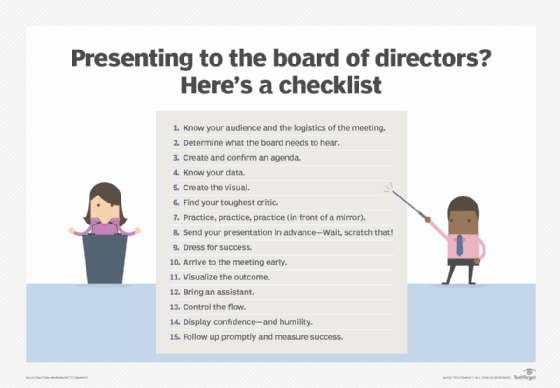How to present to the board of directors: 15 tips for a successful presentation
A board presentation can influence major decisions. Follow these 15 expert tips from Metrigy CEO and principal analyst Robin Gareiss to deliver a successful presentation.
Presenting to a board of directors requires a distinct approach from other types of presentations. Board members are responsible for guiding a company's direction and making strategic decisions, so it's essential to tailor your message accordingly. A successful board presentation involves knowing your audience, thorough preparation and being confident.
Expert best practices for presentation success
Over my career, I have had the good fortune to present to all types of audiences -- from major keynotes where the lights are so bright, I couldn't see the 10,000 people in the audience, to classroom settings with 50 or 100 people, to meetings with a handful of people in the room.
My favorite type of presentation is in a boardroom, where a group of insightful, engaged and typically smart people gather to learn, to set strategies, dream of new opportunities and make tough decisions.
While boardroom presentations are my favorite, that's not to say they are easy or stress-free. The stakes are always high during a presentation to a company's leaders, regardless of the topic. Consequently, it's no surprise that telltale signs of anxiety -- such as heart racing, sweaty palms or sleepless nights -- are in full force when these meetings loom.
This article is part of
The evolving CIO role: From IT operator to business strategist
But nerves can work in your favor if you remember the first rule of giving a talk: The amount of time and effort you put into planning and practicing directly correlates with a successful outcome. The following are some best practices I've learned that will allow you to use that healthy level of nervousness to sharpen the content of your presentation and help ensure success.
1. Know the audience and the logistics of the meeting
Before starting work, ask who will be in the meeting and get biographies and photos of each person. Understand their areas of interest, their education and their expertise. You're there for a reason, so you need to ask, "What can I offer that they don't know already?"
There are also important logistics to inquire about. Basic questions you or your assistant should ask include the following:
- Is the meeting virtual, in person, or more likely these days, a combination of both?
- What are the coordinates, including the physical address, virtual bridge, and start and end time?
- Is it OK to arrive early, and if so, can we get set up with our presentation ahead of time?
- Will there be a breakfast or lunch meeting that I should plan to attend?
- What is the dress code?
- Are there any preferences or requirements for technology, such as slide size or adapters? Will I drive the presentation from my laptop, or do we need to send it to someone (and who) prior to the meeting to load into a broader deck?
- What format of a session does the audience expect, for instance, PowerPoint versus an interactive virtual whiteboard?
- Will I have assistance in facilitating, note-taking and capturing follow-up action items?
2. Determine what the board needs to hear
Before tackling the content of your presentation, it's important to know what the audience -- in this case, the board -- defines as a successful outcome. If possible, asking right upfront will help guide the entire presentation. You could perhaps even survey attendees ahead of time to capture their goals, needs, challenges and anticipated outcomes.
For example, if success involves board members or C-level executives learning about a new technology being considered, the job is to educate them. If success for the board involves making a decision based on return on investment, run the ROI and make a recommendation.
At this point, you should estimate how much time you'll need to make the presentation successful and block out the time on your calendar.
3. Create and confirm an agenda
Based on the information gathered, create an agenda that details what the presentation will cover. Include time estimates for what will happen and when, and add extra details about each section. If necessary, ask a colleague for a peer review of your presentation agenda before sending it to the board of directors for approval or revisions. Then, revise if needed and get started on the content.
4. Know your data
No matter what you're presenting, data and metrics are key. You can be incredibly smart and experienced, but your recommendations and insights will hold more weight and be more authoritative if they are backed by data. The data might require primary research, it could rely upon existing dashboards, or it might come from third parties. But it needs to be part of your presentation.

5. Create the visual
There are many types of presentations you can create, and the proper one depends on the context. You can do a traditional PowerPoint presentation or consider whiteboard appsto deliver your visual display. If the presentation is virtual, consider using technologies that enable interactivity, such as Slido for polling, Prezi for placing you as a speaker in front of your content, or even capabilities such as Zoom or Webex's raise a virtual hand feature for questions. Overall, make sure the presentation follows these guidelines:
- Keep it straightforward. Use the presentation to make key points, but the true content should be in what you say.
- Keep it visual. Showing rows of words typed on a screen isn't adding anything to the talk track, so use visuals to enhance your message.
- Keep it simple. Don't cram too much on each slide or screen. In general, each slide should support one or two key points.
Once it's complete, make sure a colleague reviews it, which brings me to the next point.
6. Find your toughest critic
Run through the presentation with someone you consider to be a tough critic. Don't let your feelings get hurt if that person comes back with some harsh criticism -- that's good! Better now than in the boardroom.
Ask the critic to come up with tough questions, as well. That helps you prepare for what someone might ask you, and it gives you confidence that you've prepared for the tough interrogation.
7. Practice, practice, practice (in front of a mirror)
Regardless of how many times I present, I always practice for a big event. Literally, I practice out loud in front of a mirror, so I can see how I would look to the board. Am I projecting confidence or uncertainty? If the latter, it's time to reassess the content.
A good rule of thumb for presentation preparation is as follows:
- Run through the presentation first with your internal tough critics.
- Make revisions and then practice a day or two before the meeting.
- The night before, practice for a third time in front of a mirror and get a good night's sleep. Sleep is very important to success. In addition, avoid drinking alcohol the evening prior to a big presentation.
8. Send the presentation -- wait, scratch that
Many speakers recommend sending presentations ahead of time. I disagree. When sending ahead of time, the board members don't have the benefit of context. They don't know what that picture might mean, or what point that chart supports. Worse, they could come to the wrong conclusion.
I prefer sending a detailed agenda ahead of time and potentially supporting documents, including research studies, product information and background on a project. But my recommendation is to send the presentation after you've given it, so the audience has the right context. Also, there might be questions that you'd like to address or clarify in the presentation before sending it. You can then address any issues prior to sending it to the board.
9. Dress for success
This is a tougher decision than it should be. At first glance, you would think a suit is the right apparel for a board meeting, and most of the time, it is. But I've also arrived in a suit to meetings where board directors are wearing jeans and sweaters -- and then I feel too overdressed. It's acceptable to ask in the logistics meeting what the dress code is so that you align yourself with the feel of the room. Without that information, I would always dress up as a sign of respect and seriousness of the task at hand.
10. Arrive to the meeting early
Given any number of issues that could cause delay -- including traffic, car trouble or security upon entering the building -- arrive an hour ahead of the scheduled start time.
11. Visualize the outcome
Several times before any big presentation, close your eyes and visualize the outcome: You're done with the presentation, and the board members are shaking your hand, saying, "Great job! That was fantastic. I learned a lot. I trust you to lead this project."
12. Bring an assistant
If budget and permissions allow, having an assistant at the meeting is incredibly valuable to track follow-up items, take notes relevant to your role, handle any technical issues and provide any other support needed during the meeting.
13. Control the flow
It's important to stay on schedule, but you also want to allow flexibility, including time for questions. This is a balancing act. I typically like to allow interruptions at any time because if someone is hung up on something I said, they might not listen to anything else until that question is addressed.
14. Display confidence -- and humility
The practice sessions should inject confidence in your ability to deliver a stellar presentation. Remember, if you're there, you're there for a reason. You should have confidence. But that confidence shouldn't spill over to arrogance. In fact, it's important to have humility, as well. If you don't have an answer to a question, it's perfectly acceptable to say: "That's actually a great question, and I'm not sure of the answer. But I assure you, I'll have it for you after this meeting." Or "That's a great question, and I don't have a hard-data answer, but I can give you an opinion on it."
15. Follow up promptly and measure success
Once the session is over, the quicker the follow-up, the better. In fact, it's always wise to block an appropriate amount of time -- such as a few hours, a few days, or whatever you think is needed -- after the logistics call so that time is not scheduled over if you need it. Then, ask how it went and whether you achieved the predefined success criteria.
The bottom line
Following these 15 tips will help you make a better impression on your board of directors. Every boardroom presentation is an opportunity to build familiarity and credibility with leadership, and preparing the presentation with this in mind will help you create more of a future impact.
Remember, your presentation is not just about sharing information; it's also about effectively knowing your audience, defining success early on, knowing your data and practicing your presentation.
Additionally, you should craft more impactful communication to ensure your audience stays engaged. Avoid overloading your slides to avoid death by PowerPoint and to ensure a more effective presentation structure.
About the author
Robin Gareiss is CEO and principal analyst at Metrigy, where she oversees research product development, conducts primary research and advises leading enterprises, vendors and carriers. For more than 25 years, Robin has advised hundreds of senior IT executives, ranging in size from Fortune 100 to Fortune 1000, developing technology strategies and analyzing how they can transform their businesses.






